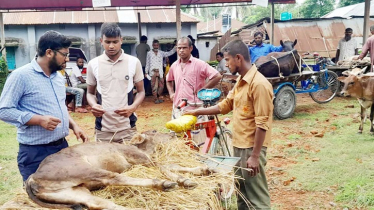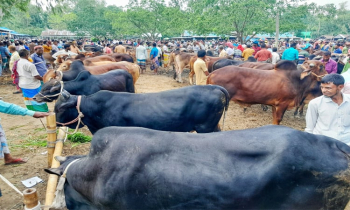
SYLHET – The Sylhet region is anticipating over three lakh (300,000) animals suitable for sacrifice during the upcoming Eid-ul-Adha. This includes locally reared livestock available in the markets, as well as a significant number of larger cattle and goats brought in by traders from other districts. Overall, more than 350,000 animals are expected to be sacrificed in the Sylhet region this year.
Dr. Maruf Hasan, the Director of the Sylhet Divisional Livestock Department, informed BSS that approximately four lakh (400,000) cattle are usually sacrificed in the Sylhet region annually. However, he anticipates a slight decrease in demand this year. Initial estimates suggest a demand for 271,500 sacrificial animals in the Sylhet division, while farmers have a stock of 308,515 animals.
He does not foresee a shortage of sacrificial animals in Sylhet this year, stating that local farmers have an ample supply. Additionally, many people sell their domestic animals during the Eid period. Traders also bring in thousands of cattle from various northern districts every year to sell at the Eid markets. Combining these sources, there will likely be a much higher number of cattle, goats, and sheep available in the markets than the actual demand.
According to data from the Divisional Livestock Office, various farms across the four districts of the division have 309,000 livestock ready for sacrifice. This includes 130,756 bulls, 32,368 oxen, 37,392 cows, 5,420 buffaloes, 77,646 goats, 24,014 sheep, and 919 other animals.
This year, the demand for sacrificial animals in Sylhet district is estimated at 83,541, while the available stock is 102,278, comprising 43,882 bulls, 15,277 oxen, 8,184 cows, 3,402 buffaloes, 24,449 goats, 7,015 sheep, and 59 other animals. Last year, the demand in Sylhet district was 150,709, with a stock of 180,921 animals.
In Moulvibazar district, the demand for sacrificial animals this year is 78,929, and the available stock is 80,637, including 32,088 bulls, 7,591 oxen, 6,901 cows, 1,272 buffaloes, 28,622 goats, and 4,163 sheep. Last year, the demand in Moulvibazar was 98,542, and the stock was 83,081 animals.
Habiganj district has an estimated demand of 65,583 sacrificial animals this year, with an available stock of 70,746, including 29,966 bulls, 5,049 oxen, 14,291 cows, 359 buffaloes, 13,202 goats, and 7,779 sheep. Last year, the demand in Habiganj was 90,638, and the stock was 102,976 animals.
Sunamganj district has a demand of 43,424 sacrificial animals this year, with an available stock of 54,854, including 24,820 bulls, 4,351 oxen, 8,016 cows, 387 buffaloes, 11,363 goats, 5,077 sheep, and 860 other animals. Last year, the demand in Sunamganj was 54,362, and the stock was 62,688 animals.
Similar to last year, the demand can be met with locally produced animals. Every farm has small, medium, and large sacrificial animals ready for sale.
Farmers have received training on fattening livestock. Additionally, courtyard meetings have been held at the upazila level to raise awareness and provide hands-on training to farmers to prevent the use of steroids. Imams of mosques and butchers have also been trained for the sacrificial process.
Dr. Maruf Hasan, Director of the Sylhet Divisional Livestock Office, stated that there is no shortage of sacrificial animals in the Sylhet division this year. Every year, traders from other districts of the country bring cattle and goats to Sylhet for sale. He believes that the number of sacrificial animals in Sylhet may increase as Eid approaches.
Drawing on past experience, he noted that many expatriates from Sylhet prefer to sacrifice large cattle on Eid day. These types of large cattle are produced in very limited quantities locally in Sylhet. Therefore, large cattle are brought to Sylhet from various districts including Kishoreganj, Netrokona, Mymensingh, and Kushtia. He expects this trend to continue this year as well.





